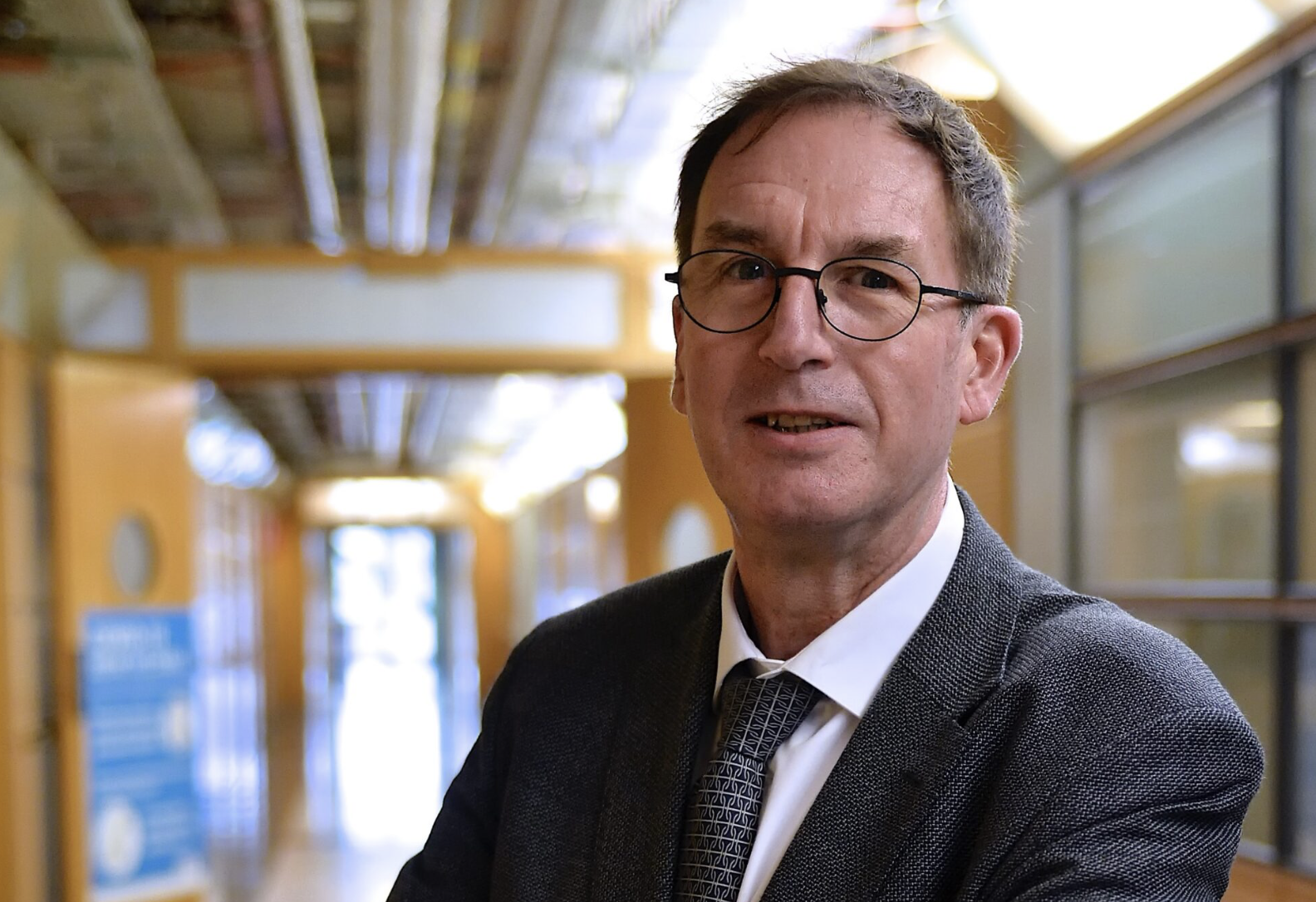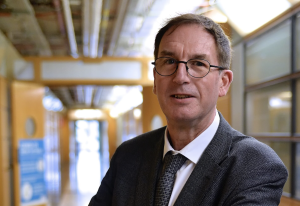Prof. Gilbert Massard was recently awarded the Lifetime Achievement Award by the European Respiratory Society (ERS). With decades of experience in lung transplantation, thoracic surgery, and medical education, Prof. Massard has been a pioneer in both clinical practice and the training of future surgeons. Congratulations, Gilbert!
Congratulations on receiving the Lifetime Achievement Award! What does this recognition mean to you?
Receiving such an award from a society with which I have worked for many years is a great honor. You should know that the European Respiratory Society is the largest scientific society worldwide dedicated to respiratory diseases, and its annual meeting attracts around 25,000 participants. Another key feature is that ERS functions much like a university: it promotes high-quality education at the same level as research; the only difference being that both activities are limited to respiratory physiology and diseases.
During the 15 years I have spent working as an ERS officer, I have been involved in many projects, although most of my efforts have focused on education.
This award—coming a couple of years after receiving the prestigious ERS fellowship (FERS)—was completely unexpected. I must admit that when I first saw the notification, I was a little surprised and even thought it might be a fake email. But I recognised the sender’s name, so I knew it was real!
Today, looking back over the past 45 years, I feel deeply grateful:
- Above all, to my mentors at the University of Strasbourg, who entrusted me and supported me throughout my academic career;
- To fate and destiny, which offered me several opportunities for research and development;
- And to the European Respiratory Society, which supported the development of thoracic surgery and transplantation in many ways: exchanging ideas with peers, editing monographs, organising postgraduate courses and external schools, and leading educational and scientific symposia and webinars. ERS also supported task force groups for guidelines, curriculum development, and many other educational initiatives.
How has the European Respiratory Society influenced your development?
The European Respiratory Society played an important role in both my personal and professional development. It fostered my interest in educational activities and allowed me to gradually develop expertise in contemporary aspects of education, such as building up curricula and evaluate learning outcomes, in collaboration with education scientists.
For example, I chaired a task force aiming to design a European training curriculum for thoracic surgeons. This helped me a lot during the 13 years I directed the European Board of Thoracic Surgery at Union Européennedes Médecins Spécialistes (UEMS), where I oversaw reshaping the Board examination which evolved from an unformal chat with peers towards a well-structures 2-part exam.
This experience also provided me with the necessary experience to build up the European Society of Thoracic Surgeons School (ESTS) during my seven-year mandate, aligning educational programmes with the European Board exam.
You were part of the early years of lung transplantation and helped shape it from an experimental procedure into a safe therapy. Looking back, what do you see as the key turning points in this journey?
Maybe some sense for feeling the right opportunity at the right time. I was appointed as a junior faculty member in autumn 1989, just as the endeavor for lung transplantation began. This was few years after the first successful single lung transplant in 1983 and the first successful double-lung transplant in 1986, both performed in Toronto, Canada.
The determining moments in my own journey were my fellowships, first in Marseille and then at Mc Gill University in Montreal, which allowed me to set up a transplant programme together with my close friend Romain Kessler, an outstanding pulmonary physician at the University Hospital of Strasbourg. Our first operation was performed on February 24th, 1993 (incidentally my father’s birthday !) and was successful.
However, I must confess that the real boost for lung transplantation came from two key factors. First, the support of Prof. Daniel Jaeck as president of the medical council at the university hospital Strasbourg. Prof. Jaeck impressed me at the time with a prophetic statement: ‘’In 20 years, cancer will be cured with pills; the remaining fields for surgery will be trauma care and organ transplantation.’’
Second, the change in financing public hospitals in France, which attributed generous fundings to organ transplantation, with estimated rewards to hospitals for each single procedure. This enabled us to build the necessary infrastructure.
The keys to success happened at three levels, including teamwork, collaboration and educational support:
The development of a multidisciplinary team together with our colleagues from pulmonary medicine and many other specialties, where Prof. Romain Kessler was an undefectible partner.
During these pioneering years, where all of us started from scratch, there has been a permanent exchange of experience with other teams in France and Europe, taking advice from each other on complicated cases.
ERS provided a support structure with the scientific group for lung transplantation, which allowed us to organise symposia and postgraduate courses at the annual conference, and externalised training schools.
Your work has also contributed to the evolution of thoracic oncologic surgery, from extended invasive resections to minimally invasive approaches. Where do you think the field is heading next?
Owing to fight against tobacco smoking and occupational risk factors, and development of screening for lung cancer, we observed a steep increase of early stage lung cancer referred for surgery. In other words, locally advanced disease requiring ‘’heroic’’ surgery has progressively given way to smaller lesions that are suitable for minimally invasive resection.
While the results of classic chemotherapy were rather disappointing, new medical treatments began to challenge traditional guidelines. Around 2005, target therapies emerged, showing remarkable results, though they were limited to a small number of patients carrying specific mutations, such as EGFR (Epidermal Growth Factor Receptor).
The real break-through of medical therapies appeared after 2015 with immunotherapy, which I consider comparable to the introduction of antibiotics to treat tuberculosis. Response rates are considerably higher and might in the future decrease the need for surgery.
The surgeon of the future will mainly face small tumors of 1 cm and less and will need to compete with stereotactic radiation therapy, a non-invasive alternative.
At the same time, advances in digitalisation of medical imaging data and 3D reconstruction are opening the way to another alternative technique: endobronchial tumour ablation. Navigation systems can guide smallcatheters to lesions located in the outer regions of the lungs for biopsy. Tumor ablation with radio frequency or microwaves, or with cyotherapy is currently under investigation.
‟ The surgeon of the future will mainly face small tumors and will need to consider stereotactic radiation therapy, a non-invasive alternative.”

Director of Medical Education
Education has been central to your career, from leading European training initiatives to directing medical education at the University of Luxembourg. What have been your main goals in training future thoracic surgeons?
Hand, head, heart! Surgical skills are important, and simulation training will play an increasing part in surgical education under the mantra “never the first time on a patient”.
The field of simulation itself is evolving rapidly. We are now approaching a stage where 3D virtual models will be reconstructed from the patient’s imaging data, enabling surgeons to practice minimally invasive surgery on a digital console using the patient’s actual anatomy. If a young surgeon is assigned to perform such an operation, they will be able — and indeed required — to train on this virtual model beforehand.
However, whatever the skills, the surgical indication and strategy are capital: one of my preferred aphorisms is to say that the surgeon becomes dangerous when he starts thinking during the operation: the main strategy and alternatives for unexpected scenarios should be defined beforehand.
Finally, ethical behavior, team spirit, empathy, availability, and other non-technical skills are fundamental values. Among the latter, critical reviews of one’s own results and academic interest must be encouraged.
Any educational initiative in medicine should start with defining learning outcomes, i.e. the main features of our “final product”. Clearly outlined learning objectives are the basis for curriculum development. The next step before launching the programme should be staffing up human resources and organising facilities and equipment.
Looking back, is there a particular scientific discovery, clinical achievement, or research breakthrough that you are most proud of?
We went through different processes that increased quality of care and patient safety such as standardisation of oncologic surgery with radical and systematic node dissection, broncho-plastic and angioplastic surgery to preserve functional lung tissue, refining prognostic factors and improving training. The major breakthroughs are to my opinion lung cancer screening (opening the way for minimally invasive surgery) and immuno-therapy (creating the new category where most of the disease responds to treatment, but a few small areas start growing again).
The same smooth evolution happened to lung transplantation. The most spectacular advances were to improve preservation of donor lungs with ex-vivo perfusion of the donor organ, where we had the chance to participate in one of the first trials. In the past, we would retrieve the lungs wherever they were available, place them into an ice box, and bring them to the recipient for implantation. But over time, we realised that thismethod achieved a sub-optimal organ preservation. Pulmonary edema would often develop in such lungs, meaning that the body might reject it. Most of the time, it wasn’t too serious, though it required longer post-transplant resuscitation. Ex-vivo perfusion means storing the lungs in a physiologic context: they are perfused with a blood-based solution at body temperature and ventilated with air containing 21% oxygen. The mostrecent advances move back to simplified modalities for organ preservation: storage at 10° without any perfusion or ventilation.
Another aspect I’m proud of is multiple organ transplantation. We developed combined lung transplantation and pancreatic Langerhans cell transfer together with Prof. Laurence Kessler, offering an innovative solution to patients with cystic fibrosis and instable diabetes.
I am also happy to have been one of the driving forces who has transformed the European Board Exam at UEMS (Union de Médecine Spécialistes) from a chat among peers to a professionally structured 2-part exam.
But if the question is about what I am really proud of: the successful careers of my trainees!
Finally, what advice would you give to young surgeons starting their careers in thoracic surgery or transplantation today?
Be present when it happens! This is the best way to learn. I love to say that I have been part of the lucky generations who grew up without European law regulating the working hours for surgical trainees.
When I started my research in the lab, working on antigen-presenting cells, my scientific mentor welcomed me by saying: “If I ever needed surgery, I wouldn’t ask whether the surgeon has a PhD — I’d rather ask whether he truly masters the surgery he intends to do on me.”
Thoracic surgery, above all, is an aggressive treatment offered to patients. While scientific curiosity is a great asset and an essential component of an academic career, the main priorities for becoming a surgeon are the development of technical skills, the ability for appropriate patient selection, and communication skills with patients and coworkers of any kind.
